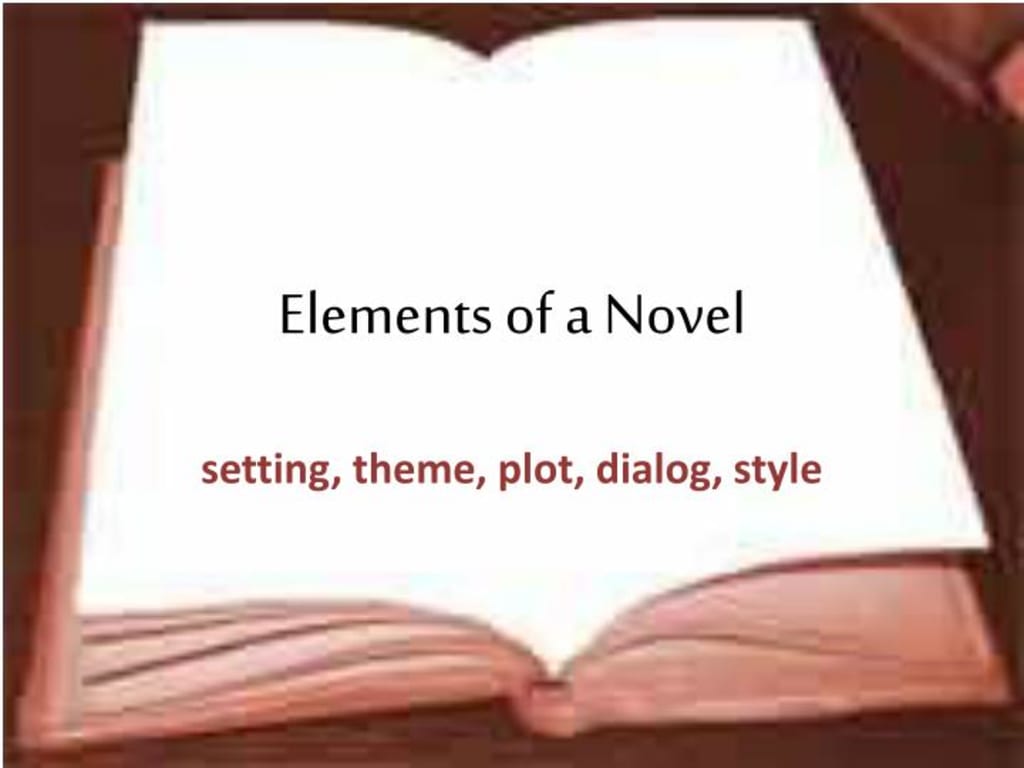Novel & Elements of the Novel
Characterization Plot Dialogue Point of View Setting Theme

The word "novel" comes from the Italian word "novella," which denotes a fresh take on an existing theme or idea.
The novel can be simply described as a long prose tale. A novel is not a brief prose story; rather, it is a detailed and illustrated account of several events that occurred throughout the life of a character. It is a comprehensive autobiography of a character from the book.
Whatever the book's intended purpose, it is clear that it captures the author's era in exquisite detail. It functions similarly to a mirror in that it reflects the image of whatever is held up to it. A novel also accurately depicts the trends, peculiarities, and characteristics of the modern period.
Scholarly Definitions
Some critics have defined the word novel differently.
Dr Tillyard defines the novel as “a novel is a not too unorganized, fictitious (fictional) narrative in prose of at least, say, 20,000 words.”
W.E Williams defines it as “a long narrative (narration/tale) in prose detailing the actions of fictitious (fictional) people.”
Elements of a Novel
The foundation (construction) of a novel is comprised of some components. Every one of these components is necessary for any novel. Without these components, no written work could fall under the category of a novel. Here are a few components of a novel:
Ø Characterization
Ø Plot
Ø Dialogue
Ø Point of View
Ø Setting
Ø Theme
1. Characterization in a Novel
A novel's characterization is a crucial component. It involves the art of developing characters for a book or play. Through characterization, the author reveals the personalities of the characters. Direct characterization and indirect characterization are the two types of characterization.
When a character is directly characterized, the author tells us who they are upfront. He can reveal a character's temperament (or disposition) by using a variety of descriptive adjectives. Name, location, relationship, age, job, mindset, behaviour, etc. are all part of one's identity. Consider the following instances:
He is undaunted, fearless and above all an honest man.
She is the queen of beauty and an embodiment of feminine virtue.
In the aforementioned lines, the modifiers applied undoubtedly uncover the identity of the character.
While the author uses a variety of strategies for indirect characterization to highlight the essence of the character. He conveys the character's individuality through his actions, voice, conduct, and appearance. For instance, Antony's speech after killing Julius Caesar in William Shakespeare's tragedy Julius Caesar completely reveals his distinctive characteristics of Antony. It reveals his personality to us. It demonstrates his ability to inspire people to rise in rebellion against Julius Caesar's killers through his speech. Similar to this, Hamlet's soliloquies in William Shakespeare's famous tragedy Hamlet reveal his character. It demonstrates Hamlet's philosophical outlook. Look at his soliloquy, where Hamlet's personality is both obvious and understandable:
To be, or not to be, that is the question:
Whether 'tis Nobler in the mind to suffer
The Slings and Arrows of outrageous Fortune,
Or to take Arms against a Sea of troubles,
And by opposing end them: to die, to sleep
No more; and by a sleep, to say we end
The Heart-ache, and the thousand Natural shocks
That Flesh is heir to? (Hamlet by Shakespeare)
Each novelist needs to construct several characters to aid in the development of the plot. These types include round characters and flat characters.
Characters are classified as either flat or round, with flat characters remaining the same throughout the narrative and round characters evolving. In any type of fiction, rounded characters are crucial. They are the ones who carry the narrative forward.
For instance: In his lecture Aspects of the Novel, E.M. Forster distinguished between round characters and flat characters. In this aspect, Charles Dickens is a superb illustration. In his novels, he presents a lot of rounded and flat people. Consider his book Great Expectations, in which Mr Joe remains the same throughout the story but Mr Pip goes through various changes and is unquestionably an exact illustration of a rounded character. Mr Joe, who is a terrific friend and helper to Mr Pip, is not someone he wants to meet since he forgets his modest beginnings.
2. Plot in a Novel
The distinction between a plot and a story can be seen in Aristotle's statement that "Plot is the order of episodes." "The King died and the queen died," according to E.M. Forster, is a narrative. The plot is "The King died and the Queen died of sadness." A story or the novel's framework is the plot. It is a crucial component of a book. The plot is similar to a building's pillar. If we take away the pillar, the entire structure will undoubtedly fall. Similar to how a story cannot be structured without a plot.
Every novel's narrative often includes the following elements: Exposition, Rising Action, Climax, Falling Action, and Dénouement. These crucial story components are covered in further detail below:
i. Exposition
The first stage of the plot is exposition. Every novel begins with the introduction of several characters. The interactions between these people advance the plot.
ii. Rising Action
Exposition leads to rising action. The action in the book builds gradually until it reaches its climax, which is also known as the plot's climax. It consists of several incidents, disputes, and enemies. It also carries the designation of complexity.
iii. Climax
The most crucial phase of a plot is the climax. It is Rising Action's heightened climax. Rising Action's climax marks the beginning of the Climax. This section of the plot is generally regarded as the most poignant (arising effect), turbulent (disruptive), provocative, and motivating in all novels. The reveal of Pip's donor is the book's climax in Charles Dickens’s Great Expectations. The novel's culmination is Pip realizing who his true sponsor is.
About the Creator
Zia ullah
Hi there, I am here to highlight my blog named as "Academic Blog".
Enjoyed the story? Support the Creator.
Subscribe for free to receive all their stories in your feed. You could also pledge your support or give them a one-off tip, letting them know you appreciate their work.






Comments
There are no comments for this story
Be the first to respond and start the conversation.